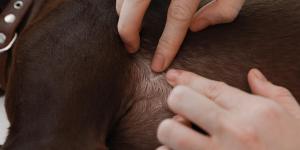Swedish Lapphund

The Swedish Lapphund is a Spitz dog breed from Sweden, one of three Lapphund breeds that evolved from a type of dog used by the Sámi to herd and guard their reindeer. Its thick coat and cunning appearance give this dog a very sweet and peculiar look. It stands out as an exceptional working dog that is intelligent, noble and very active, perfect for adventurous owners who enjoy spending time outdoors with their dogs.
If you want to know more about the Swedish Lapphund dog breed, visit us at AnimalWised. Here you will find a detailed breed file with information about the physical characteristics, temperament, grooming, health and much more. We also provide photos, so you can see what the dogs look like.
- Europe
- Sweden
- Group V
- 5-14
- 14-18
- 18-22
- 22-27
- 27-31
- More than 31
- 2-7
- 7-22
- 22-55
- 55-100
- 100-220
- 8-10
- 10-12
- 12-14
- 15-20
- Low
- Meidum
- High
Origin of the Swedish Lapphund
The Swedish Lapphund is the oldest of the native Swedish breeds and is considered one of the oldest breeds still in existence today. As its name suggests, it originated in Lapland, a large geographic region spanning northern Norway, Finland, Sweden, and part of Russia. There, the Lapphund was considered an invaluable companion for the nomadic tribes of the Sami, who inhabited the area hundreds of years ago.
The Sami first used these dogs as hunters, but over time their primary function changed, and the Swedish Lapps were mainly used to guard and herd reindeer herds. A characteristic of the herding Lapps is the use of their vocal talents. It is believed that the Sami favored the barking Lappies for two reasons: predators were discouraged from approaching them too closely, and the reindeer knew that the barking four-legged creature was friend and not foe. The herding instinct is still alive and well in the modern Lappie.
Today, there are still some Swedish Lapps that work as herding dogs, accompanying Swedish and Finnish shepherds and checking on their sheep. However, most Lapps today are companion dogs.
Physical characteristics of the Swedish Lapphund
The Swedish Lapphund is a compact, medium-sized Spitz. Both males and females weigh about 20 kilograms (44 pounds) when full-grown and measure between 40 and 50 centimeters (15 and 19 in) at the withers. Among the most important physical characteristics are:
- The limbs are short and muscular.
- The tail is completely hairy and curved over the back.
- The eyes are large, expressive and dark brown.
- The muzzle is thin and elongated.
- The ears are erect, triangular, and small.
Swedish Lapphund dog breed coat colors
One of the most significant physical characteristics is undoubtedly its dense coat, which can be:
- Bear-brown
- Black
- Brown
- black and brown
Completely black specimens, however, are the most common in the breed. The coat is double-coated, and the hair is characterized by being lush, shiny, smooth and particularly long on the tail, the back of the legs and the neck.
Temperament of the Swedish Lapphund
The Swedish Lapphund is a working dog. They tend to love physical activity, are easy to train, and are very intelligent. They usually have no difficulty learning new skills through positive reinforcement. Their lively and bright temperament makes them an ideal companion for people who enjoy dog sports, as the Lappie is not only an excellent herding dog, but also an excellent breed for agility, tracking, and other training methods.
However, the Swedish Lapphund is also a versatile dog that adapts to a quieter family life as long as their needs are met, it is provided with proper training, and they receive sufficient physical and mental stimulation.
With their caregivers, this breed is friendly, tolerant, and affectionate. However, unlike other breeds, they do not constantly seek human contact. Like other Nordic breeds, the Lappie tends to be somewhat independent. On the other hand, it is a very alert and quite barking dog that does not hesitate to warn of the presence of people or foreign elements approaching their home.
Continue reading this other article if you want to know more about intelligence games you can play with your dog to stimulate them mentally.
Care of the Swedish Lapphund
As a hardy breed, the Swedish Lapphund is quite low maintenance. Even though they have no special needs, their physical and mental well-being depends on certain standards of care.
- Nutrition: the Swedish Lapphund should do well on a good quality dog food, whether it is commercially available or home prepared under the supervision and approval of your veterinarian. Some dogs are prone to obesity. Therefore, pay attention to your dog's caloric intake and weight. Treats can be an important aid in training, but too many treats can lead to obesity.
- Exercise: Swedish Lapphunds are a medium to high energy breed and benefit from daily exercise. They are very energetic, alert, and active, but can also calm down and relax. Regular mental and physical exercise is necessary to keep this breed from becoming bored. This breed should not be left alone for long periods of time. If you keep them outdoors, a fenced yard is a must.
- Grooming: Lappys have a medium length, double coat that should be brushed weekly and bathed occasionally. Swedish Lappys shed their undercoat at least once or twice a year, which is called "blowing". A groomer can be helpful during this time to remove the large amount of fur they shed. A Swedish Lapphund's coat should never be shaved and should maintain its natural length throughout the year.
Training of the Swedish Lapphund
The Lapphund has a tremendous ability to learn, is very intelligent and alert, and enjoys physical activity and training new skills. This breed is usually quite friendly and sociable with other dogs and people. However, in order for them not to develop behavioral problems, it is important to be patient and take time for their socialization, especially during puppyhood.
Although they learn very quickly, this breed gets bored easily if the training sessions are too long or monotonous. Eventually, it can cause them to lose interest completely and become stubborn or frustrated. Raising a Lappie requires a light hand, patience, and a sense of humor, for they have an independent spirit and is occasionally stubborn. They are well suited for herding, agility, obedience, and other dog sports.
The best way to train this dog is playfully and always with positive reinforcement. The use of punishment or other aversive techniques can cause serious behavior issues in the dog.
Continue reading this other article if you want to learn more about how to train a dog with positive reinforcement.
Health of the Swedish Lapphund
In general, this breed is very hardy and in good health. However, some aspects should be taken into account to give this dog a long and healthy life. Some of the main diseases that can affect the Swedish Lapphund are the following:
- Progressive retinal atrophy: a hereditary eye disease that attacks the dog's retina and leads to gradual loss of vision.
- Hip dysplasia: also a hereditary joint problem caused by a malformation of the hip joint, resulting in pain, lameness, and gait problems. If diagnosed in time, it is possible to treat it and even correct it through surgery.
- Periodontal disease: the accumulation of tartar and plaque leads to infections in the gums of the animal, damaging the teeth and in many cases requiring extraction of the damaged teeth. In addition, if left untreated, the infection can spread to other organs of the body, endangering the dog's life. To avoid this, it is important to brush the lappet's teeth at least once a week and, on the advice of the veterinarian, to perform dental cleanings at regular intervals.
- Diabetes: as in humans, diabetes in dogs results from the body's inability to produce or use insulin. The main symptoms of diabetes in dogs include apathy, increased food and water intake, increased urine production and weight loss. If caught early enough, diabetes is treatable and allows the dog to live an almost normal life.
Of course, it is essential to follow the vaccination and deworming schedule established by the veterinarian to prevent the animal from becoming ill and to perform a complete annual examination after the seventh or eighth year of life.
Where to adopt a Swedish Lapphund?
Currently, there are very few specimens of the Swedish Lapphund, and most of them live in the Nordic countries, especially in Sweden. This makes it quite difficult to find Lappies for adoption, as the breed is not very well known outside of Sweden.
It is always a good idea to contact animal shelters and animal welfare societies that specialize in this breed, as many of them allow their animals to travel to the city where the adopter lives. However, remember that what is really important when including a new member in the family is not that they meet any breed standard, but that you can accommodate their needs and lifestyle.
Swedish Lapphund photos














